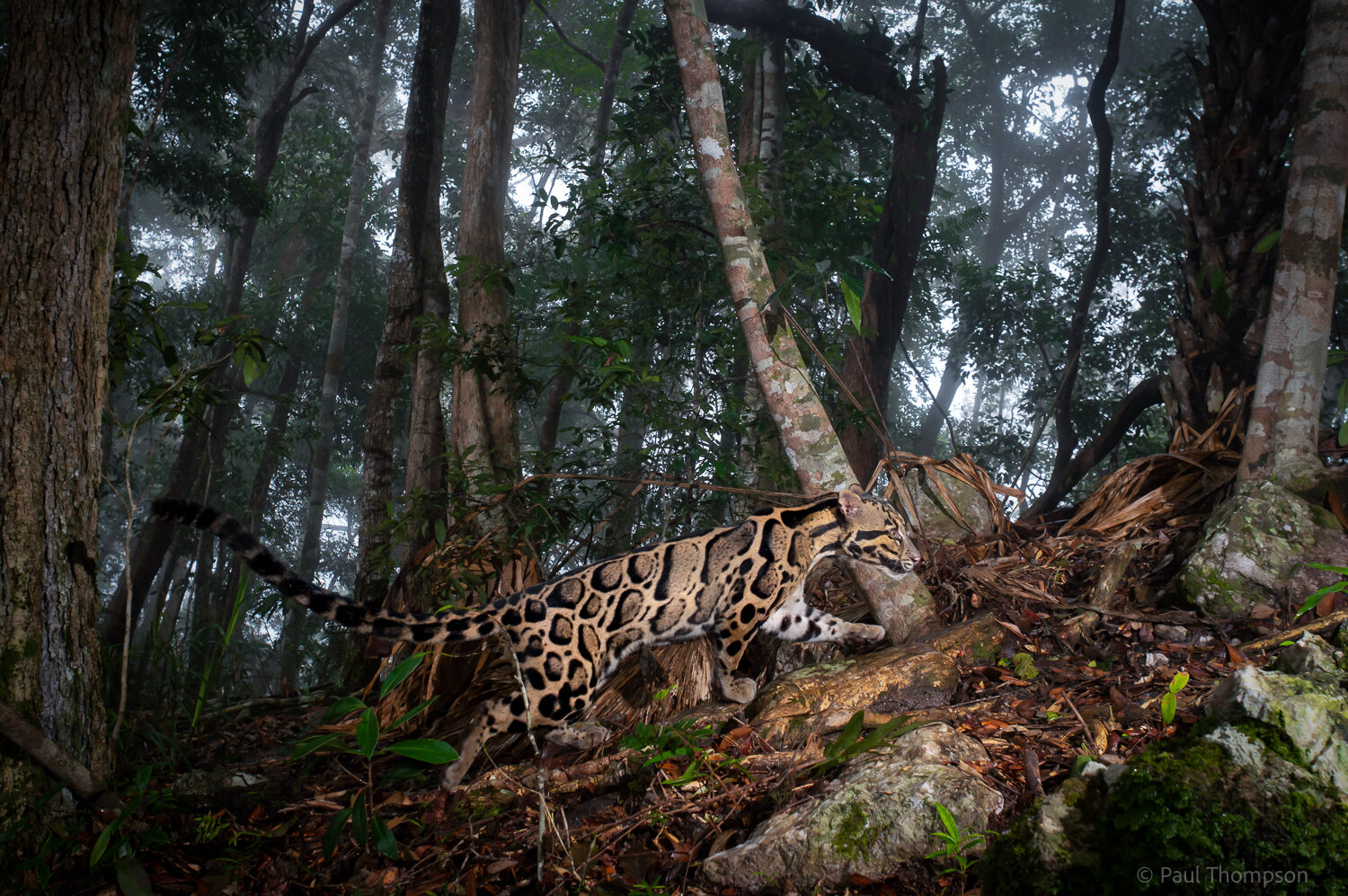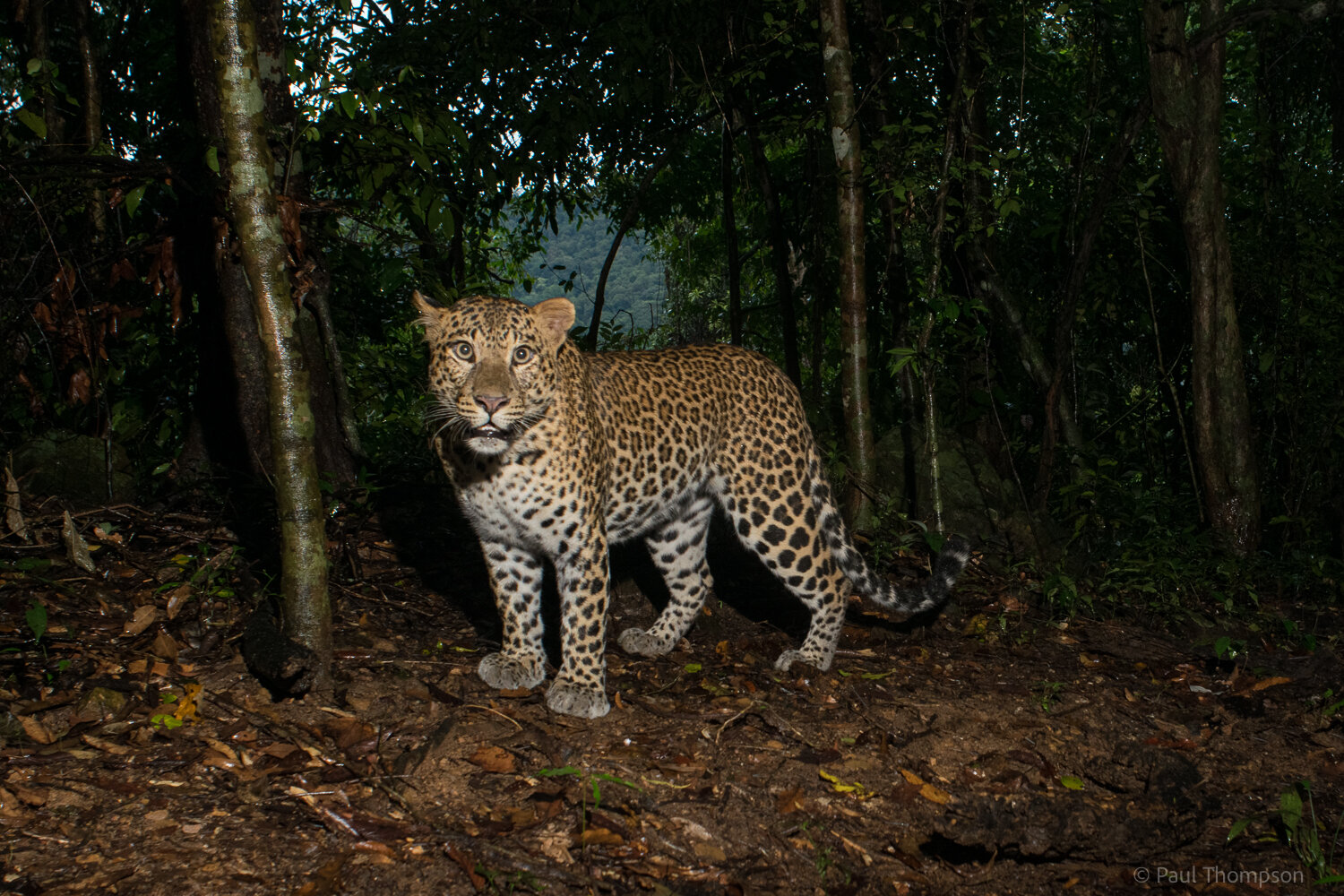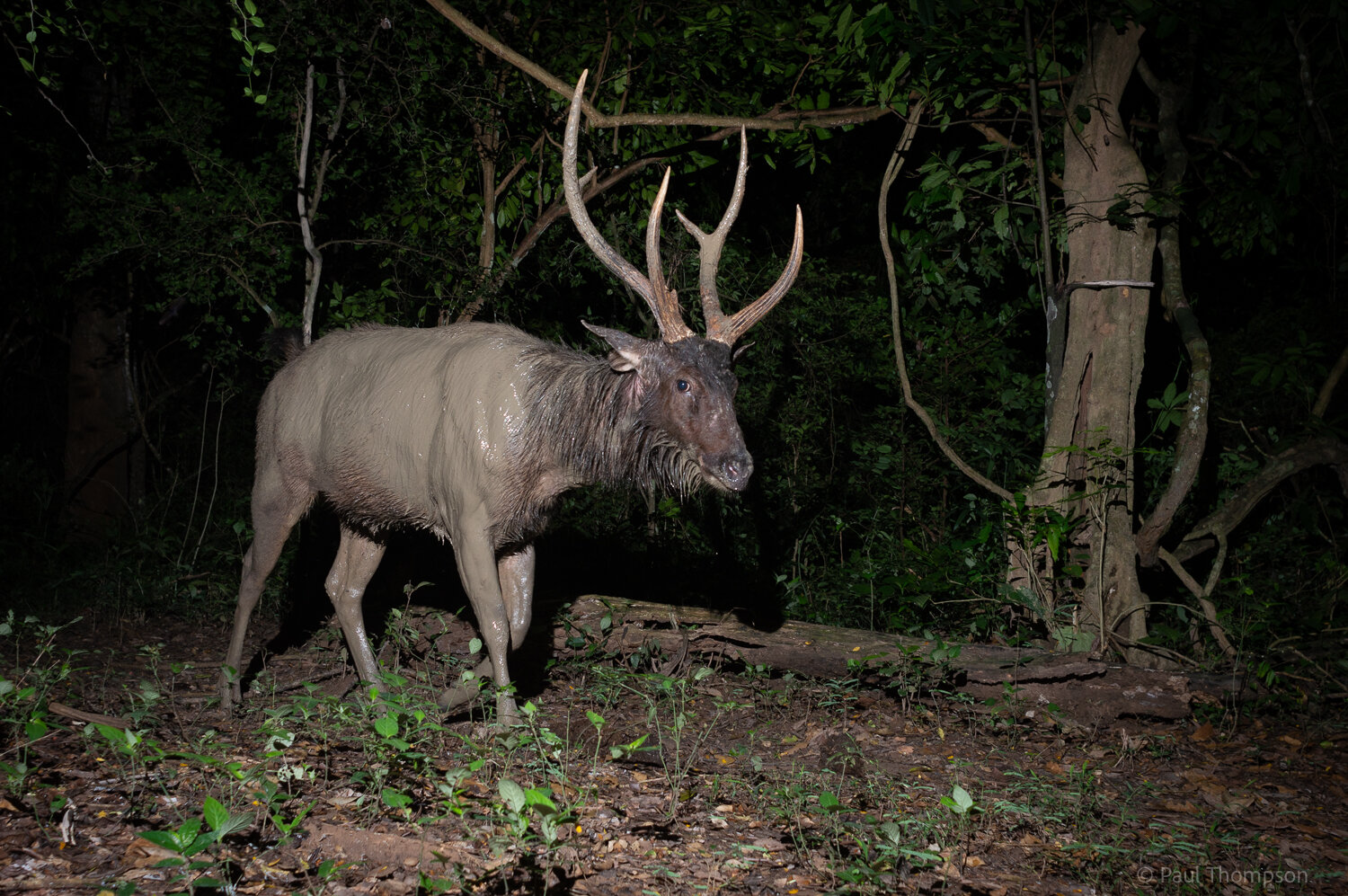
THE WILD HEART OF THAILAND
Paul Thompson
Conservation photographer Paul Thompson has spent fifteen years setting up remote camera traps to capture the beauty and the biodiversity found deep within Thailand’s tropical forests, turning traditional camera trapping used by conservationists into a fine art. The result is a captivating collection of images providing unrivalled insight into the individual lives of species, and into the wild heart of Thailand.
After photographer Paul Thompson saw a tiger in the wild in Thailand’s Dong Phayayen-Khao Yai forest complex - an event not experienced by some who have spent decades studying the animals - he set out to photograph one of the country’s elusive big cats. Using self-constructed DSLR camera traps that are left in the forests for months on end, he has devoted huge amounts of planning and effort to obtain this remarkable collection of images, showcasing the beauty of Thailand’s threatened and endangered species. His photographs have been used by the government of Thailand and conservation organisations to highlight the plight of the country’s biodiversity in the face of development projects, poaching and habitat loss that threatens wildlife across the region. (Banner image: Paul’s capture of a black leopard coming over the prow of a hill in Thailand’s Kaeng Krachan National Park.)
“…savage monsoon rains that flood and destroy the cameras; constant equipment failures in the severe jungle conditions; monkeys that swing on the flash cables…”
Read our Q&A with Paul Thompson, where he describes the process involved in achieving his photographs of endangered species and enigmatic wildlife in Thailand’s remote forests.
A portrait of the wild: Paul’s stunning picture of a now Critically Endangered Indochinese leopard (Panthera pardus delacouri).
“The photographic process starts with studying google earth, area maps, and seeking anecdotal information in order to find valleys and tracks that offer the promise of fauna, either resident or transitory…larger traps are self constructed. It’s a design that took a few years to evolve as it kept having to be adjusted to overcome problems we witnessed when deploying the cameras in the field for extended periods of two to three months a time.”
Read more about Paul Thompson’s wildlife photography process in his Q&A.
In 2019, Indochinese leopards were elevated to ‘Critically Endangered’ status on the IUCN’s (International Union for the Conservation of Nature) Red List of Threatened Species. In Thailand they are resident in less than 5% of the country but protection is probably the best of those countries in which the Indochinese leopard still survives. With a decreasing worldwide population and an estimate of less than 750 individuals of the Indochinese subspecies, it’s imperative that those wild areas which still support their populations are protected and clear of encroachment and hunting pressures.
Arboreal Beauty: The clouded leopard (Neofelis nebulosa) so named because of its beautiful markings which afford it perfect camouflage in the forest, is currently listed as Vulnerable on the IUCN Red List of Threatened Species.
“When I am in a pristine section of tropical forest, where man has so far failed to influence the habitat and the perfection of a functioning bio-diverse forest, I get a feeling. It’s an almost spiritual feeling, one that it inspires awe in me. It is my realisation that this is what mother earth intended, what the whole of Southeastern Asia would be like if we as a species did not exist. Everything in harmony, life abundant, every organism playing a role both in life and death.” -
Paul Thompson
Stormy skies behind the striking ‘fire cat’ as it is known in Thai language, or in English the Asian golden cat (Catopuma temminckii). Asian golden cats can appear in many different colour morphs, including rosettes, darker brown, and greyish but are so named for their bright gold, burnt orange colour.
“The trials are many and the tribulations few, but when it all comes together it is an amazing feeling - an accomplishment against incredible odds. The reality is that you need to survive the trials to feel the eventual tribulation.”

Cloaked in a sea of mist: A spectacular clouded leopard in Thailand’s rainy season clouded forests; the length of the leopard’s tail becomes apparent in this capture.
“It was on one of my forest macro trips in the Dong Phayayen–Khao Yai Forest Complex that I had the incredible experience of seeing a wild tiger. From that day on the seed was set and my mind was stuck on the question - how could I photograph a wild tiger in Thailand? There was only one realistic answer, a camera trap.”
The Indochinese tiger (Panthera tigris corbetti) is nigh on impossible to see in the wild in the forests of Southeast Asia, which is why Paul set out to use his remote camera traps to try to capture glimpses of them. Providing evidence of the tiger still existing in some forests has been vital for conservation organisations to secure funding in order to try and conserve them. Capturing three tigers in one frame - a mother and two cubs (seen below)- on this occasion provided conservationists with important evidence of breeding in this protected area.
The future of tigers: As poaching and habitat loss threatens the survival of the wild tiger in Southeast Asia, evidence of breeding and seeing cubs survive to adulthood is critical information for conservationists, and vital to improving their chances.
Light in the dark: Paul’s self-made DSLR camera traps use two side-by-side heat sensors that signal a controller when one half of the frame goes warmer than the other, such as when an animal enters the frame from one side. This activates a control board to fire the camera and flashes two times in rapid succession, the first fire charges the flashes and the second takes the picture.
Tropical heat. Thundering rains. Herds of elephants. The process of gathering these images of Thailand’s wildlife is one of endurance. Paul’s cameras are left to fend for themselves in the forests for weeks and sometimes months on end, where they are vulnerable to a multitude of external influences that can result in mechanical failure. It’s a gamble with weather, fauna and fate until weeks later when the results - good or bad - are uncovered upon recovering the cameras from their locations.
“If my camera-traps could speak they would tell you about: ants finding the dryness of the camera and strobe enclosures the perfect place to build their nests; the bears that pry open the cameras to feed on the ants; the poachers that steal the cameras to keep their identities secret; the poachers who built a fire under the camera as they could not get it off the tree; the male elephants who are hell bent on destroying the cameras; the elephant herds of female and young who are intrigued by the cameras and play with them; the mustelids who eat the sensor covers; the wasp nests; the savage monsoon rains that flood and destroy the cameras; constant equipment failures in the severe jungle conditions; monkeys that swing on the flash cables; pigs that use the cameras as scratching posts; battery failures; the weird fungus growths in the equipment; light leaks; falling trees; to name just a few.”
The Asian or Asiatic elephant (Elephas maximus). Wildlife rangers patrolling In the tropical forests of Thailand, will remark that they are most cautious to avoid Asian elephants, which can be extremely dangerous when they charge.
Spectacular portrait of an Endangered cat: the Indochinese leopard (Panthera pardus delacouri), of which there are an estimated only around 750 individuals remaining.
The characterful Sun bear (Helarctos malayanus), so named for its golden or white patch on the chest, is an omnivore. This image portrays the sun bear’s extremely long claws, which it uses to open termite nests and trees.
Gaur (Bos gaurus), the world’s tallest wild cattle species. Gaur habitat is characterized by large, relatively undisturbed forest tracts, hilly terrain below an altitude of 5000 to 6000 m, availability of water, and an abundance of forage in the form of grasses, bamboo, shrubs, and trees. Their number remaining in Thailand is in the low hundreds.
What inspires you to continue your work in photography?
”On a purely internal level its the enjoyment I get from being in nature. It does not matter if it’s deep within a virgin forest trying to photograph a rarely seen mammal or sat by a reed bed next to an industrial estate in outer Bangkok trying to photograph a common bird. I just feel better when surrounded by nature. The Japanese have a well known phrase for it, shinrin-yoku, which describes simply being in nature, connecting with it through our sense of sight, hearing, taste, smell and touch.”
< Below, a 200 kilogram wild tiger moves through the darkness past one of Paul’s cameras >

"The trials are many and the tribulations few, but when it all comes together it is an amazing feeling - an accomplishment against incredible odds;" a stunning tigress in Thailand's lowland dipterocarp forests.
It took Paul three and a half years to obtain an image of marbled cat (Pardofelis marmorata) in this protected area. Like the other small cats of Southeast Asia, marbled cats are difficult to observe and thus their ecology has been little studied.
Indochinese leopard (Panthera pardus delacouri) of the regular, rosetted colour morph prowling Thailand's forests. The typical leopard pictured here is the same species as a melanistic or black leopard, which are so coloured due to a recessive gene. Cubs from the same litter can appear in different colour morphs.
The most common wild cat in Thailand, the diminutive leopard cat (Prionailurus bengalensis). Despite its versatility, and as with all Thailand's wild cats, leopard cat populations are still declining due to habitat loss and hunting.
The binturong, or 'bearcat' (Arctictis binturong) is an arboreal creature and is one of the very few mammals outside of monkeys that possesses a prehensile tail, which it uses to navigate life in dense forest environments.
The elusive banded linsang (Prionodon linsang); this striking small carnivore is likely highly arboreal. The banded linsang and spotted linsang (Prionodon pardicolor) are the two Asian linsang species, and were formerly classified as part of the civet family (Viverridae), but are now known to comprise their own separate family, the Prionodontidae.
A Stump-tailed macaque (Macaca arctoides) family group. A distinctly differing look from the rest of the macaque species in Thailand the stump-tailed macaque’s distinguishing features are its long reddish brown coat as well as a pronounced red face and a very short stump for a tail that often cannot be seen.
The Indochinese Serow (Capricornis maritimus) is a solitary, elusive, forest-dwelling goat-antelope, and allegedly the closest ancestral forms to wild sheep and goats (Caprinae).
The Hog Badger (Arctonyx collaris), so named for its hog-like snout, and also known as the greater hog badger, is a terrestrial mustelid native to Central and Southeast Asia. The hog badger is omnivorous, its diet consists of fruits, roots and small animals. They are currently listed as Vulnerable on the IUCN Red List of Threatened Species.
The red muntjac (Muntiacus muntjak), or 'barking deer', so named for its distinctive alarm call that sounds like a bark. Muntjacs are amongst the most wide ranging of Southeast Asian mammals, and can be found at altitudes from sea level up to around 3000 metres.
The masked palm civet (Paguma larvata), resembles other civets of the family Viverridae with the unique exception that its brown to gray fur completely lacks spots, stripes, and other markings besides the clear mask on its face.
A large male sambar deer (Rusa unicolor) fresh from a mud bath. Preferred prey species of the tiger, when sensing danger a sambar will stamp its feet and make an alarm call known as "pooking" or "belling".
“When I show a picture of a cryptic species to a Thai person and they reply “Do we really still have those in Thailand?” …Those moments inspire me because it’s another minor victory in the battle to make bio-diversity awareness more prominent in the public’s mind and therefore, hopefully, aid conservation in some small way.”
The Asian tapir (Tapirus indicus) is classified as Endangered on the IUCN Red List of Threatened Species. In Southeast Asia its occurrence can be divided into three relatively distinct sub-populations. The Asian tapirs' range limits appear to be constrained by climatic limitation – they occur only in tropical moist forest areas.
The resplendent Siamese Fireback (Lophura diardi), Thailand’s national bird. Just visible on the plumage of the bird in the background is the bright yellow spot, the reason the ‘fireback’ gets its name.
“We had been targeting a male tiger in that particular area since we first glimpsed him a year before. I still have not gotten that tiger on this particular ridge but the melanistic indochinese leopard image more than makes up for that.” Paul’s stunning image of a black leopard coming over the prow of a hill in Thailand’s Kaeng Krachan National Park.
















